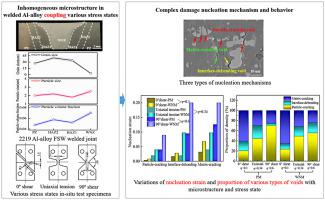当前位置:
X-MOL 学术
›
Prog. Nat. Sci. Mater. Int.
›
论文详情
Our official English website, www.x-mol.net, welcomes your
feedback! (Note: you will need to create a separate account there.)
Effect of void nucleation on microstructure and stress state in aluminum alloy tailor-welded blank
Progress in Natural Science: Materials International ( IF 4.8 ) Pub Date : 2020-11-01 , DOI: 10.1016/j.pnsc.2020.10.007 L. Xing , M. Zhan , P.F. Gao , M. Li , Y.D. Dong , T.Y. Wang
Progress in Natural Science: Materials International ( IF 4.8 ) Pub Date : 2020-11-01 , DOI: 10.1016/j.pnsc.2020.10.007 L. Xing , M. Zhan , P.F. Gao , M. Li , Y.D. Dong , T.Y. Wang

|
Abstract The microscopic damage initiation characteristic in welded joint greatly determines the subsequent damage evolution and fracture behavior of aluminum alloy tailor-welded blank (TWB) during plastic forming. In this study, the interactive dependence of void nucleation on microstructure and stress state in the welded joint of a 2219 aluminum alloy TWB was quantitatively explored by in-situ SEM testing. Moreover, a micromechanical model based on actual microstructure was adopted to reveal the underlying mechanisms from the perspective of microscopic heterogeneous deformation. The results showed that three void nucleation mechanisms, including particle-cracking, interface-debonding and matrix-cracking, coexisted in the deformation at different microstructure regions and stress states. The nucleation strain of each mechanism mainly depended on the particle volume fraction, grain size and stress triaxiality. Besides, the proportions of particle-cracking and interface-debonding greatly varied with the grain size and particle volume fraction, and the variation law changed with the stress state. The proportion of matrix-cracking had a weak dependence on the microstructure, while increased with the stress triaxiality decreasing. It made the damage initiation in aluminum alloy welded joint transit from particle-cracking dominance to matrix-cracking dominance with the stress triaxiality decreasing. The micromechanical modeling results suggested that the changes of evolutions and distributions of Mises stress in particle, hydrostatic stress at interface and plastic strain in matrix with microstructure and stress state were responsible for the above effects.
中文翻译:

空洞形核对铝合金拼焊毛坯组织和应力状态的影响
摘要 焊接接头的微观损伤起始特性极大地决定了铝合金拼焊板(TWB)塑性成形过程中的后续损伤演化和断裂行为。在这项研究中,通过原位 SEM 测试定量探索了 2219 铝合金 TWB 焊接接头中空隙形核对微观结构和应力状态的交互依赖性。此外,采用基于实际微观结构的微观力学模型,从微观非均相变形的角度揭示了潜在机制。结果表明,在不同微观结构区域和应力状态下,变形过程中同时存在颗粒开裂、界面脱粘和基体开裂三种空隙形核机制。每种机制的形核应变主要取决于颗粒体积分数、晶粒尺寸和应力三轴度。此外,颗粒开裂和界面脱粘的比例随晶粒尺寸和颗粒体积分数变化很大,变化规律随应力状态而变化。基体开裂的比例对显微组织的依赖性很小,随着应力三轴度的降低而增加。随着应力三轴度的降低,铝合金焊接接头的损伤萌生由以颗粒开裂为主转变为以基体开裂为主。微观力学建模结果表明,粒子中Mises应力的演化和分布变化,
更新日期:2020-11-01
中文翻译:

空洞形核对铝合金拼焊毛坯组织和应力状态的影响
摘要 焊接接头的微观损伤起始特性极大地决定了铝合金拼焊板(TWB)塑性成形过程中的后续损伤演化和断裂行为。在这项研究中,通过原位 SEM 测试定量探索了 2219 铝合金 TWB 焊接接头中空隙形核对微观结构和应力状态的交互依赖性。此外,采用基于实际微观结构的微观力学模型,从微观非均相变形的角度揭示了潜在机制。结果表明,在不同微观结构区域和应力状态下,变形过程中同时存在颗粒开裂、界面脱粘和基体开裂三种空隙形核机制。每种机制的形核应变主要取决于颗粒体积分数、晶粒尺寸和应力三轴度。此外,颗粒开裂和界面脱粘的比例随晶粒尺寸和颗粒体积分数变化很大,变化规律随应力状态而变化。基体开裂的比例对显微组织的依赖性很小,随着应力三轴度的降低而增加。随着应力三轴度的降低,铝合金焊接接头的损伤萌生由以颗粒开裂为主转变为以基体开裂为主。微观力学建模结果表明,粒子中Mises应力的演化和分布变化,











































 京公网安备 11010802027423号
京公网安备 11010802027423号